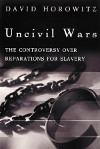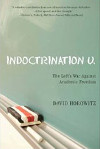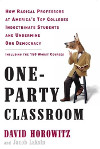Uncivil Wars Reviews
By: Jamie Glazov
Monday, January 21, 2002
A review of Uncivil Wars, which chronicles David Horowitz’ attempts to initiate genuine debate on the dangers of the slavery reparations movement and the U.S. academia’s hostility to any such debate.
THE CONTEMPORARY CONTROVERSY over reparations for slavery lies at the heart of the culture war in America today. David Horowitz, the former Leftwing radical-turned Conservative, has just struck another stunning blow against the Left in his new book, Uncivil Wars. The Controversy Over Reparations For Slavery. He effectively dismantles the arguments for reparations, exposes the totalitarian mindset of the politically correct university campus that bolsters them, and provides a robust defense of American society and institutions.
Today, nowhere is support for reparations stronger than in American institutions of higher learning, where tenured radical academic elites literally control free thought and expression. Indeed, the campus thought police has shut down debate on the reparations issue, demonizing and marginalizing those who dare to trespass the correct political line.
Enter David Horowitz.
In Uncivil Wars, the Conservative intellectual exposes the pitiful state of tolerance in American academia. The book provides a detailed account of how the fascist Left has attempted – unsuccessfully — to prevent Horowitz’s cunning presentation of anti-reparations ideas to university students.
Because Horowitz’s ideas are anti-Left — and therefore not permitted on American campuses or in the curricula of academic courses –- the author realized that he had to try a different tactic (other than writing scholarly work) to get his ideas into American universities. In the winter and spring of 2001, he tried to initiate a dialogue by airing his anti-reparations arguments in an advertisement, titled “Ten Reasons Why Reparations for Blacks Is a Bad Idea for Blacks — and Racist Too,” in college newspapers. This effort resulted in a violent attack on Horowitz and his character, as storm trooper and character assassination tactics were inflicted against him, as well as against the newspapers that carried his ad.
Uncivil Wars provides an account of how many student newspapers refused to carry Horowitz’s ad, while others that did run it quickly caved into the Left’s intimidation tactics, pulled the ad and even denounced themselves Maoist-style. At Berkeley, students stormed the offices of The Daily Californian to demand an apology after the newspaper ran the ad. They got one. At Brown, student protesters threw away thousands of free copies of The Brown Daily Herald, after the paper printed the ad.
In light of this madness, Horowitz decided to go on what he termed his “Freedom Tour,” in which he risked his personal safety by going to college campuses (who would dare have him) to defend his ad. “It was a way,” he writes, “of going `in your face’ to my accusers and emphasizing the issue, free speech, which had now become the heart of the debate.”
Horowitz’s visit to Berkeley epitomized best the Stalinization of the American university campus. He describes his eerie experience:
“I was whisked in through a back entrance to a `holding room’ where I was to stay until my speech. All hallways were secured by uniformed officers so that no stray students might stumble across my path. When I had to leave the holding room briefly to go to the bathroom, I was accompanied by six armed guards who checked the stalls before I was allowed to enter. The experience was surreal. The bracing Berkeley campus of my youth had been replaced in the forty years since I studied there by an atmosphere lacking only bomb-sniffing dogs to complete the sense of menace conveyed to `the Other.’ The only comparison that came to mind was that of a neighborhood once habitable and inviting for evening strollers, which had become occupied by roving thugs.”
The Left’s objective was not just to censor Horowitz’s ideas, but, in the tradition of totalitarians, to erase the individual behind them. Horowitz notes,
Horowitz did, of course, have his many defenders in the reparations controversy. They included the distinguished black scholar Thomas Sowell and the editors of the USA Today, the Boston Globe, the Philadelphia Inquirer, the Chicago Tribune, the Arizona Republic, and many other papers. In other words, when it came to the real world outside of academia, sanity and tolerance still prevailed.
After chronicling the Leftist attempt to smother his voice and defame his character, Horowitz goes on to outline meticulously the flaws of the reparations claim. The last chapter, “Reparations and the American Idea,” is a literary masterpiece that belongs in the curriculum of every American History course in the country. In just 32 pages, the author gives a profound and robust defense of America and its institutions. Providing a fresh and shrewd perspective of American history, he de-legitimizes reparations claims for the speciousness and flawed historical perspective on which he shows they are based. He presents us with the facts about the history of world slavery and emphasizes what the reparations proponents consistently ignore: “America’s role in the global tragedy of slave systems involving Africans, while bad enough, was relatively minor compared with the roles of Arabs, Europeans and Africans themselves.”
In making this vital point, Horowitz gets to the core of the matter: the reparations idea is a product of a historical revisionism that seeks to paint America in its most evil light. Thus, the author detects that “The reparations claim is a hostile assault on America and its history.” This is precisely why, as Horowitz shows, reparations advocates always demonize the American Founding Fathers and the framework they created. Horowitz, therefore comes to the defense of George Washington, Thomas Jefferson, and Abraham Lincoln, protecting them from their slanderers and praising the values and institutions they molded. He reminds us that,
The crucial point to stress here is that these reparations to descendants of slaves, which were designed to compensate African-Americans and to uplift them, ultimately hurt the very people they were designed to help. Horowitz notes,
It is by no means a surprise, therefore, that Horowitz finds Marxist ideology -– and all the class and racial hatred that comes along with it -– to be the crucial underpinning of the reparations agenda. He writes:
Horowitz looks deep into the reparations argument to isolate and discredit its Marxist lies. He shows that, by trying to blame “discrimination” for the achievement gaps between blacks and other ethnic groups, the Left is spouting only a false ideology — and no kind of science. He reveals that, if anything, the whole Marxist/reparations charade is founded on the belief in the inferiority of the black race, since it robs African-Americans of their own free will. The whole reparations claim, therefore,
It becomes understandable, therefore, why the reparations proponents seek to divide and harm America, and intend to do so by instilling class and racial antagonism where it doesn’t exist. Horowitz crystallizes this Leftist objective by demonstrating the incompatibility between pro-reparations arguments and real-life realities. For instance, he shows that only a tiny minority of Americans ever owned slaves and that the majority of Americans today are descended from post-Civil War immigrants who have no relationship to slavery at all. The GNP of black America, meanwhile, is so large that it makes the African-American community the tenth most prosperous “nation” in the world. Thus, he asks the crucial question:
In the end, Horowitz’s attack on the reparations claim blends with his defense of the American idea and democracy itself. He emphasizes that,
Uncivil Wars forces all Americans to confront the pathological illness that resides in their institutions of higher learning. While in the 1950s the university saw itself as having the mission of facilitating a diverse pursuit of knowledge, today it serves solely as the Left’s vehicle for political indoctrination and social change. It is here that lies Horowitz’s vital and ominous warning.
Uncivil Wars is also clearly very much a personal story. It is about one man’s decision to become a warrior in a war that, by necessity, exacts a large personal sacrifice. But as an individual who comes from the Left’s former ranks, and who has witnessed the violence and death that the progressive ideology inflicts, Horowitz has clearly discerned that standing on the sidelines in the culture war is a luxury he cannot afford. It is for this reason that, in this work, as in his previous ones, he comes out swinging with the gloves off. The fight for America is on, and, as Uncivil Wars reveals, it is being lost on the university campus. Unlike many of his Conservative contemporaries, the author is ready and willing to go down fighting alone — alongside the American virtues and principles that are now under vicious attack.
Despite its attempt to wipe its arch-rival out of reality, the American Left continues to face its ultimate nightmare: David Horowitz is still standing -– and talking. More troubling to the Left yet: he doesn’t seem like he’s going anywhere anytime soon. On a smaller scale, Horowitz represents to the academic Left what Alexander Solzhenitsyn represented to the Soviet regime; he exemplifies the irritating and threatening reminder to tyranny that human freedom, and the triumph of the human spirit, can ultimately never be suffocated or suppressed.
Uncivil Wars is a remarkable achievement — written by an intellectual heavyweight who has been barred from academia. Tragically, tens of thousands of young minds in American universities will be robbed of the essential necessity of reading this scholarly gem. But the history of totalitarian regimes offers hope. Who could have guessed, after all, during Joseph Stalin’s reign, that, within one generation, for a brief moment in time, Russians would be able to read freely One Day in the Life of Ivan Denisovich? If that miracle occurred in the midst of the Soviet monstrosity, then who can say that, one day, there may not be a thaw in the Left’s despotic control of thought in American academia? The hope remains that maybe even within a generation, a miracle might occur inside the classrooms of academic indoctrination — and the eyes of university students will, perhaps even for a precious and magical moment, be allowed to fall on the forbidden pages of Uncivil Wars.
Jamie Glazov is Frontpage Magazine’s editor. He holds a Ph.D. in History with a specialty in Russian, U.S. and Canadian foreign policy. He is the author of Canadian Policy Toward Khrushchev’s Soviet Union and is the co-editor (with David Horowitz) of The Hate America Left. He edited and wrote the introduction to David Horowitz’s Left Illusions. His new book is United in Hate: The Left’s Romance with Tyranny and Terror. To see his previous symposiums, interviews and articles Click Here.




